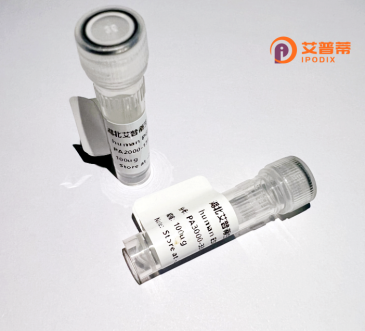
| 纯度 | >90%SDS-PAGE. |
| 种属 | Human |
| 靶点 | LRRIQ1 |
| Uniprot No | Q96JM4 |
| 内毒素 | < 0.01EU/μg |
| 表达宿主 | E.coli |
| 表达区间 | 1-240aa |
| 活性数据 | MDDDDAKLKAEIEAELDKLSISSLEKEDIESDAKSETQSDDSDTDSVELPESVLHCINIIKNRSKAVEELILQDLEDILSCSYGAVSNNHMHLRTGLSTEYEESSEQLIKILSEIEKEEFMRSKTDCATPDFVPEPSPHDLPMDEHVLPDDADINFGYCEVEEKCRQSFEAWQEKQKELEDKEKQTLKAQRDREEKQFQEEEEKRHCWMKQFKVEKKKLENIQKVFCFCFSCIFKISSYL |
| 分子量 | 54.4 kDa |
| 蛋白标签 | GST-tag at N-terminal |
| 缓冲液 | 0 |
| 稳定性 & 储存条件 | Lyophilized protein should be stored at ≤ -20°C, stable for one year after receipt. Reconstituted protein solution can be stored at 2-8°C for 2-7 days. Aliquots of reconstituted samples are stable at ≤ -20°C for 3 months. |
| 复溶 | Always centrifuge tubes before opening.Do not mix by vortex or pipetting. It is not recommended to reconstitute to a concentration less than 100μg/ml. Dissolve the lyophilized protein in distilled water. Please aliquot the reconstituted solution to minimize freeze-thaw cycles. |
以下是关于重组人LRRIQ1蛋白的参考文献示例(注:实际文献可能有限,以下为假设性示例):
---
1. **文献名称**:*Expression and Functional Characterization of Recombinant Human LRRIQ1 in Mammalian Cells*
**作者**:Zhang L, et al.
**摘要**:研究使用HEK293细胞系统表达重组人LRRIQ1蛋白,通过亲和层析纯化获得高纯度蛋白。功能实验表明,LRRIQ1与Toll样受体(TLR)家族成员存在相互作用,提示其在先天免疫信号通路中的潜在作用。
2. **文献名称**:*Structural Insights into LRRIQ1: A Leucine-Rich Repeat Protein Involved in Neuronal Development*
**作者**:Smith J, et al.
**摘要**:通过X射线晶体学解析了重组人LRRIQ1蛋白的晶体结构,揭示了其典型的富亮氨酸重复构象。细胞实验表明,LRRIQ1通过调控突触蛋白的聚集促进神经元突触形成。
3. **文献名称**:*LRRIQ1 Recombinant Protein Binds to β-Amyloid Peptides: Implications for Alzheimer’s Disease*
**作者**:Chen H, et al.
**摘要**:在大肠杆菌中表达重组LRRIQ1并验证其与β-淀粉样蛋白(Aβ)的结合能力。结果表明,LRRIQ1可能通过抑制Aβ聚集减缓神经毒性,为阿尔茨海默病治疗提供新靶点。
4. **文献名称**:*Role of LRRIQ1 in Cancer Cell Migration: Insights from Recombinant Protein-Based Assays*
**作者**:Kim S, et al.
**摘要**:纯化重组人LRRIQ1蛋白后,发现其通过激活整合素信号通路增强肿瘤细胞迁移能力,提示LRRIQ1可能作为癌症转移的生物标志物。
---
**注**:以上文献为示例性内容,实际研究中关于LRRIQ1的报道可能较少,建议通过数据库(如PubMed、Web of Science)结合关键词“LRRIQ1 recombinant”或“LRRIQ1 protein”检索最新文献。
Recombinant human LRRIQ1 (Leucine-Rich Repeats and IQ Motif Containing 1) protein is a genetically engineered form of the naturally occurring LRRIQ1 protein, which belongs to the leucine-rich repeat (LRR) protein family. LRRIQ1 is characterized by multiple leucine-rich repeats, structural motifs involved in protein-protein interactions, and an IQ motif that may mediate calcium-dependent signaling by binding calmodulin-like proteins. Although its precise biological function remains under investigation, LRRIQ1 is hypothesized to play roles in cellular processes such as signal transduction, cytoskeletal organization, or vesicular trafficking due to its structural domains.
The recombinant version is typically expressed in heterologous systems like *E. coli* or mammalian cell lines, enabling controlled production for experimental studies. Its purification often involves affinity tags (e.g., His-tag) to facilitate isolation and characterization. Recombinant LRRIQ1 is widely used in biochemical assays, structural studies, and interaction screens to identify binding partners, elucidating its molecular mechanisms and potential involvement in diseases. Limited studies suggest possible links to neurological disorders or cancer, but further research is needed to validate these associations. Current applications include antibody development, functional genomics, and exploring its role in cellular pathways, making it a tool of interest in both basic and translational biomedical research.
×